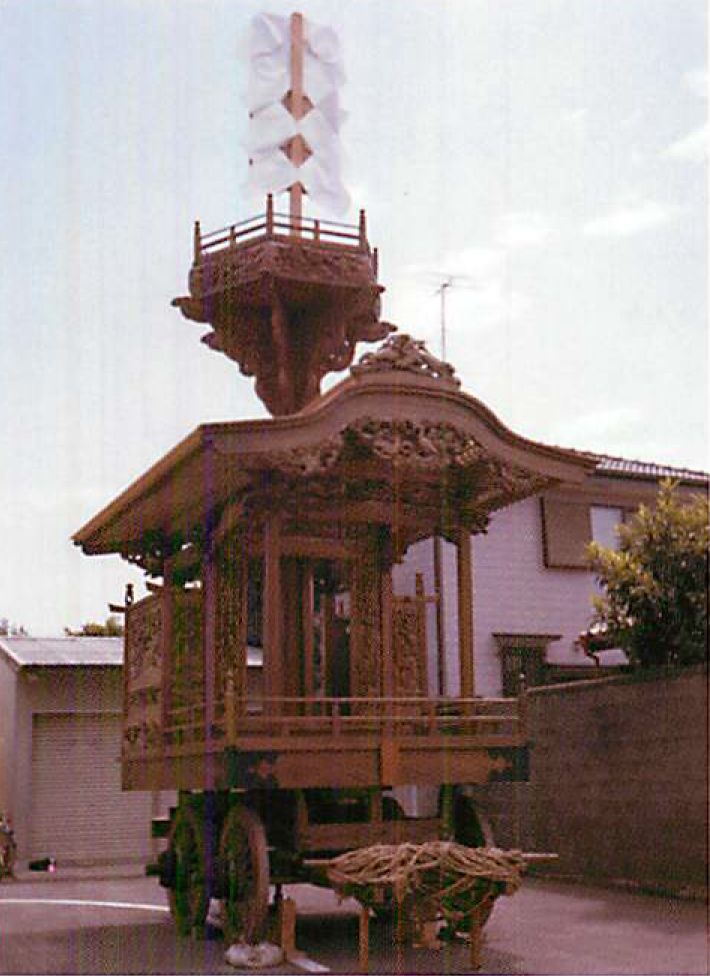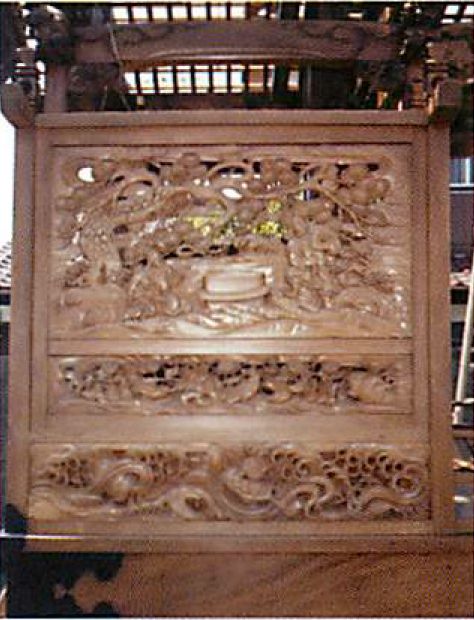| <所在地 瑞穂町石畑1848番地> | <Location: 1848 Ishihata, Mizuho> |
| 石畑地区は、近世より東西二地区に区分されており、西半を「石畑上(いしはたかみ)」、東半を「石畑下(いしはたしも)」と呼んでいた。この山車は石畑上の山車で、明治12年(1879年)頃(明治7・8年頃の説もある。)に石畑上の大工、吉岡助右衛門が同地区にある御嶽神社の欅を使って建造したとの伝承がある。 | The Ishihata district was recently divided into two districts, east and west. The western half is called "Ishihata-kami" and the eastern half is called "Ishihata-shimo."This float is from Ishihata-kami, and it is said to have been built by an Ishihata-kami carpenter in 1879 (or, possibly in 1874 or 1875) named Sukeemon Yoshioka, using a zelkova tree in Mitake Shrine, also located in Ishihata-kami. |
| また、石畑下では石畑上よりも数年早くに八王子ないし砂川村(現立川市)から山車を購入していたが、明治43年(1910年)に所沢町下町(現所沢市)に売却した。なお、この山車は現在所沢市の有形文化財に指定されている。 | Ishihata-shimo purchased a float from either Hachioji or Sunagawa (present-day Tachikawa) several years before Ishihata-kami, but it sold the float to Shitamachi, Tokorozawa (present-day Tokorazawa City) in 1910.The float is currently designated as tangible folk cultural property by Tokorozawa City. |
| 石畑の山車の様式は、殿ヶ谷のそれとほぼ同じで、一本柱単層単層唐破風屋根人形山車(たんそうからはふやねにんぎょうだし)、梁間(はりま)一間、桁行(けたゆき)二間造り。異なるのは、一本柱が「中建て方式」で建てられる点で、これは屋根に設けた穴から一本柱を差し込む方式であり、類例は非常に少ない。 | The Ishihata float is similar to the Tonogaya float, with a single-layer gabled roof, a single interjoist (harima) and two purlins (ketayuki).What differs is that the pillar is built toward the center in the "nakatate style," where the pillar protrudes through a hole in the ceiling. Few examples of this style exist. |
| 脇障子と胴羽目には「二十四孝」を題材とした人物、虹梁(こうりょう)上の「牡丹」、妻飾りの「乙姫と浦島」といった見事な彫刻が施されている。江戸時代後期から明治前葉にわたり活躍した「彫徳」と呼ばれる江戸日本橋住の彫刻師によるものと伝えられている。 | The sliding doors and side panels on the main structure feature a sculpture depicting the "twenty-four filial exemplars." The arched beam has stunning sculptures of peonies and the gable ornamentation depicts the story of Otohime and Urashimataro.It is said that these were carved by "horitoku," carvers from Nihonbashi, Edo, who flourished from the end of the Edo period to the start of the Meiji era. |

